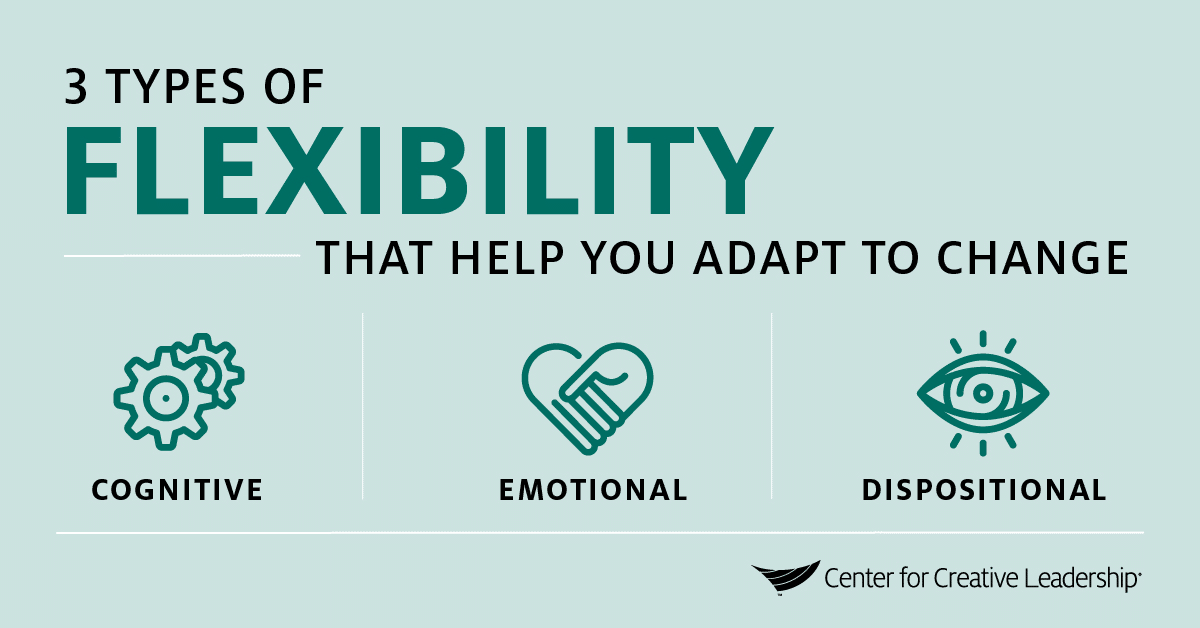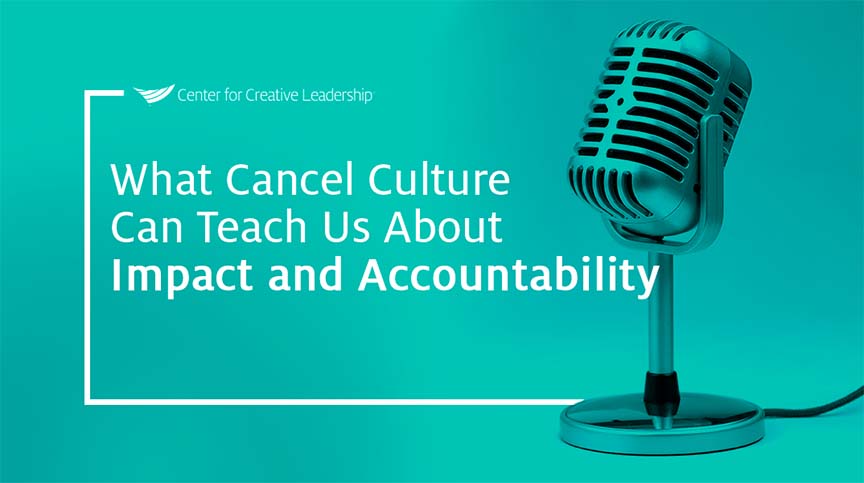How To Adapt To Change In The Workplace
- LEADING EFFECTIVELY Article
Adapting to Change Requires Flexibility

How to Be a More Flexible Leader
At present more than ever before, leaders all over the earth are facing alter and complexity — the coronavirus pandemic has presented us all with new challenges, new circumstances, and new uncertainties in the workplace. Jobs accept been morphing, expanding, shrinking, and disappearing; co-workers, teammates, and engineering science are changing rapidly.
And as nosotros seem to exist turning a corner with vaccines and organizations are gradually shifting back to in-person work, there volition be a new set of norms to suit to and challenges to overcome.
Adaptability is a requirement. Considering change is constant and inevitable, leaders must be flexible to succeed.
Our research confirms this imperative to adapt. Adjustability is nigh having ready access to a range of behaviors that enable leaders to shift and experiment as things change.
Here's what adapting to modify for successful executives means in North America and Europe:
- Adapt to the changing external pressures facing the organization;
- Conform their management style to changing situations;
- Accept changes equally positive;
- Revise plans equally necessary; and
- Consider other people's concerns during change.
Conversely, the inability to develop or adapt was the most frequently cited reason for career derailment among Due north American managers.
That'due south considering inflexible leaders limit the workplace adaptability of others. New initiatives may be halted or stifled. Resistance to change may undermine critical projects or arrangement-wide implementation, causing non only setbacks in progress, but also leading to anxiety and negative emotions from other squad members. Employee enthusiasm, cooperation, morale, and creativity are jeopardized, making it all the more than difficult to run the business or organization. (Learn more than almost how flexible leaders keep their career on rail and avoid derailment.)
Are You lot a Flexible Leader? How Well Do You Adapt to Modify?
Consider your personal approach to alter. How do you respond when adapting to change? Practise you lot:
- Accept the alter as positive?
- See the modify as an opportunity?
- Adapt plans as necessary?
- Chop-chop master new applied science, vocabulary, operating rules?
- Pb the change by example?
- Take into account other people's concerns?
- Sort out your strengths and weaknesses fairly accurately?
- Admit personal mistakes, learn from them, and move on?
- Remain optimistic?
If few or none of these responses describes yous, you're not alone. Many of us get stuck, experience anxiety with change, have a hard fourth dimension letting become, or merely don't know how to keep in unknown territory.
As noted in our guidebook Adaptability: Responding Finer to Change, to survive change in your arrangement, industry, or profession, you lot must first lead yourself through the process of transition.This includes finding ways to aid yourself experience more grounded amidst potential negative emotions, agreement the impact that change is having on yous, and understanding the touch on of your behavior on others.
When you are involved in leading change, remember that there are 4 core questions that every employee wants answered:
- What is happening?
- Why is it happening?
- How will this touch on me and my job?
- What's the plan for getting there?
Being proactive and answering these questions earlier they ask can exist beneficial. Learn more virtually our recommendations on how to transition through modify.
Accepting Change and Assessing Your VIEW
Once you've evaluated your response to alter, information technology's important to consider the way your view models the way for others in your organization to comprehend change. Employees take cues from their leaders near how to answer — which is why you demand your own bespeak of VIEW of how to accept, embrace, and lead through change. A leader must be:
- Visionary. Focus on today'due south results while likewise imagining the future. Exist willing to challenge the condition quo, take calculated risks, and anticipate the unexpected.
- Inspiring. Sell the vision and its benefits. Be passionate, model the intended change, and encourage employees to join the changing time to come.
- Enthusiastic. Maintain a positive, focused attitude that energizes others to overcome barriers. Be persistent and involve others to collaborate.
- Wise. Exude business acumen and cognition of the organization, its people, and processes. Be able to anticipate and address issues every bit a problem solver.
The three Types of Flexibility That Aid in Adapting to Alter
If yous want to improve your power to adapt to change, do the three components of adaptability in the workplace: cerebral flexibility, emotional flexibility, and dispositional flexibility.

1. Cognitive Flexibility: Leverage the ability to use different thinking strategies and mental frameworks.
Leaders who take cognitive flexibility are able to incorporate different thinking strategies and mental frameworks into their planning, decision-making, and management of solar day-to-day work. They tin can simultaneously hold multiple scenarios in mind and can see when to shift and inject a change.
Cognitive flexibility indicates nimble, divergent thinking, an interest in developing new approaches, the power to see and leverage new connections, and the propensity to work well beyond the organization. These leaders readily learn from experience and recognize when quondam approaches don't work.
2. Emotional Flexibility: Harness the ability to vary ane'due south approach to dealing with emotions and those of others.
Leaders with emotional flexibility vary their approach to dealing with their own and others' emotions — an surface area that many leaders oftentimes fail to consider. An emotionally flexible leader is comfy with the process of transition, including grieving, complaining, feet, and resistance.
Adapting to change requires give and have betwixt the leader and those experiencing the change. A leader without emotional flexibility is dismissive of others' concerns and emotions and shuts down discussion. At the same time, an emotionally adaptive leader moves the change or agenda frontwards.
iii. Dispositional Flexibility: Practice the ability to remain optimistic and, at the same time, realistic.
Leaders who display dispositional flexibility (or personality-related flexibility) operate from a identify of optimism grounded in realism and openness. They will acknowledge a bad situation but simultaneously visualize a ameliorate future. They are neither blindly positive nor pessimistic and defeatist. Ambivalence is well-tolerated.
Dispositionally flexible leaders see change as an opportunity rather than as a threat or danger.
Past learning and practicing behaviors that heave your cognitive, emotional, and dispositional flexibility, you tin become more adaptable and, in plough, help others to adapt.
How to Accommodate to Alter: 5 Tips for Flexible Leaders
As noted in our white paper on adaptable leadership, executives who display adjustability are flexible. They seek new and innovative ways to solve problems, master new skills, and view disruption equally a challenge rather than a threat — all needed to prevail through uncertain times.
Equally a leader, you not merely accept to respond to alter in the workplace, but you also have to the steer change. Employ these 5 tips to finer suit to modify and guide your squad forrard:
- Be curious. Ask lots of questions. Wonder, explore, and consider before you judge and decide.
- Don't get besides attached to a single plan or strategy. Have Plan B (and C) at the ready.
- Create support systems. Don't go it alone. Expect to mentors, friends, coaches, trusted peers, professional person colleagues, family members, and others to serve as your support arrangement in times of modify. Encourage employees to do the same.
- Understand your own reactions to change. Yous take to be clear about your own emotions and thoughts about changes, and so y'all can be straightforward with others.
- Immerse yourself in new environments and situations. Do this when you are confronted by change — but become practice by joining activities, meeting new people, and trying new things on a regular footing.
Want to know more about how to become a more than flexible leader? Lookout man our webinar, How to Foster Flexible Leadership in Times of Instability.
Ready to Take the Adjacent Step?
Build flexible leaders on your team with the capacity to adapt to alter effectively. Partner with us to arts and crafts a customized learning journey for your leaders using our inquiry-backed modules. Bachelor leadership topics include Emotional Intelligence, Leadership Agility, Leading Through Alter & Disruption, Psychological Safety, and more.
| What to Explore Next
| Related Solutions
SUBSCRIBE
Subscribe to our eNewsletters to become the latest on cutting-border, leadership insights & research.
Leading Effectively Staff
Well-nigh the Writer(s)

Leading Finer Staff
This article was written past our Leading Effectively staff, who analyze our decades of pioneering, expert research and experiences in the field to share content that volition aid leaders at every level. Subscribe to our emails to get the latest inquiry-based leadership articles and insights sent direct to your inbox.
Related Content

Podcasts
Lead With That: What Cancel Culture Can Teach Usa About Affect and Accountability
Pepe Le Pew, Elmer Fudd, Yosemite Sam, fifty-fifty Minnie Mouse – all impacted past cancel culture. Dave Chappelle, Joe Rogan, Gina Carano, J.K. Rowling – whether an animation character or just simply an blithe grapheme, no one's safe. But is it cancel or result? And actually, how does it impact you, working with and on teams and leading people through modify? Join us equally nosotros explore how leaders can make room for people to acquire from their mistakes while also honoring the sentiments of those around them. We'll take a look at how we every bit leaders can residuum the benefits and consequences of cancel civilization and pb with that.
More than

Podcasts
Lead With That: What Facebook'southward Rebrand to Meta Can Teach Us About Change and Transformation
Facebook – a company that changed the way the net was used and the mode people continued with one another – recently announced their rebrand to Meta. What are the practical implications of a prominent company changing its proper noun and its mission, and how can nosotros examine the shift from a leadership perspective? In this episode we'll swoop into the way an individual'due south leadership brand can impact their influence, and how leading change and transformation requires management, alignment, and delivery. We apply what we know about change to what we see happening with Facebook'south transformation and how nosotros can lead with that in heed.
More

Leading Effectively Articles
Source: https://www.ccl.org/articles/leading-effectively-articles/adaptability-1-idea-3-facts-5-tips/
Posted by: maglioneaboustinger.blogspot.com


0 Response to "How To Adapt To Change In The Workplace"
Post a Comment